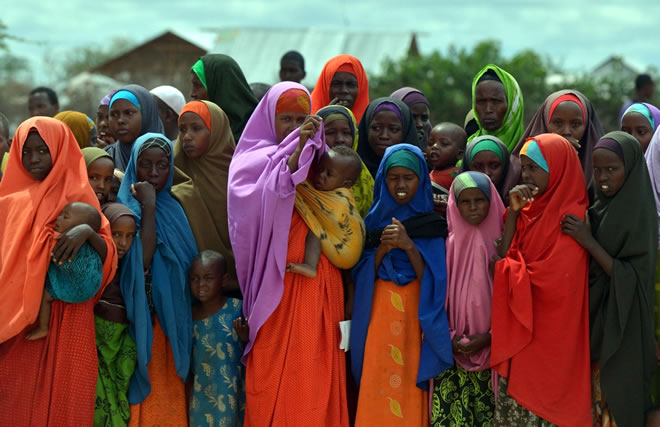After years in Dadaab, Ibrahim Hussein is one of many refugees facing a return to Somalia after the Kenyan government’s order to close the camp

Mélanie Gouby in Dadaab
Wednesday, May 20, 2015

Half of the population of Dadaab refugee camp is under 18 … refugees at the camp, 8 May 2015. Photograph: Tony Karumba/AFP/Getty Images
For Ibrahim Hussein, it was the final blow. When the Kenyan government ordered the closure of the Dadaab refugee camp following the al-Shabaab terrorist attack in Garissa in April, Hussein gathered his courage and went to the UN refugee repatriation office to ask to be resettled back home in Somalia. After years of living in the largest refugee complex in the world, Dadaab had become an open-air prison to him, with little more to offer than a daily dose of anxiety.
“I came here because of the famine in 2011. I am a farmer. There is nothing for me here, I cannot work. We are not getting much food either,” says Hussein, seated in the office of the UN refugee agency, the UNHCR. “And now they accuse us of being responsible for the attack. It’s not bearable.”
Located halfway between the Somali border and the Kenyan town of Garissa, andhome to an estimated 334,600 Somali refugees, Dadaab has once again become the focus of the Kenyan government’s response to terrorism after the massacre of 147 students at the University of Garissa last month.
Ten days after the attack, Kenya’s vice-president, William Ruto, gave the UN until July to relocate all the refugees and close the camp, saying that Dadaab has become a hideout for al-Shabaab in Kenya. “The group which attacked Garissa earlier this month … they stayed in the refugee camps,” said Bunow Korane, the chair of Kenya’s Refugee Affairs Commission. “They assembled their arms there.”
According to security experts, however, there is no evidence linking Dadaab or refugees to al-Shabaab and the Garissa attack.
Although this is not the first time that Kenya has demanded the closure of Dadaab following a terrorist attack, and despite government assurances that Somali refugees would not be forcibly repatriated, the announcement has created panic in the camp.
Issa Maaciye, a UN repatriation officer, says he has seen an increase in the number of people turning up at his office since the government’s statement. “It is not voluntary repatriation,” Maaciye explains. “It is fear.”
Hussein says he knows there is insecurity in Baidoa, the Somali city where he intends to relocate his family. Since December 2014, the UNHCR has run a pilot project for voluntary repatriation to areas of Somalia deemed safe for refugees, including Kismayo, Baidoa and Luuq.
Resources are scarce in these areas, including land, and experts fear that the return of refugees en masse could create further tensions.
Before leaving Dadaab, Hussein will have to take a fitness test. He will be given $80 (£50) for each member of his family, and will be offered some practical advice. He will also be told that he can change his mind about boarding the UN bus out of the camp up until the last minute. “Above all, I want to be free,” he says.
More than 2,000 people have made use of the repatriation scheme so far, and a 2014 survey found that less than 3% of Dadaab’s refugees intended to return toSomalia within the next two years. Meanwhile, more than 3,000 new refugees have arrived in the camp since December.
Across the yard from the repatriation office where Hussein is organising his return, Maryan and her husband Ali are registering their baby son, Hassan, so that he is added to their food ration card. Both Maryan and Ali grew up in Dadaab, and have no recollection of life in Somalia. Over the years, more than 100,000 babies have been born in the refugee camp, and today half of the camp population is under 18.
“Those who were born here don’t want to go to Somalia. They would be facing a new world. They could be easily radicalised by al-Shabaab, as they would have to take arms or be killed. There is no freedom in Somalia right now,” says Mohammed Yusuf, an 80-year-old Somali elder.
There is not much freedom in Dadaab either. Under the camp’s dystopian system, Maryan and Ali were able to survive living in tents made of plastic sheeting distributed by the UNHCR, and eating food distributed by the World Food Programme. It has been a life of acronyms, monotonous rations, and dependency on humanitarian aid, confined to a few kilometres square in the middle of the desert.
Maryan gave birth to Hassan in a hospital run by Médecins Sans Frontières, receiving a level of healthcare that she could not have had in Somalia. But if “going back” means nothing to her and her husband, staying does not seem a viable option either. “We have a son now. He cannot live like we did. But no one offers us any real option. Where are we meant to go?”
Source: The Guardian